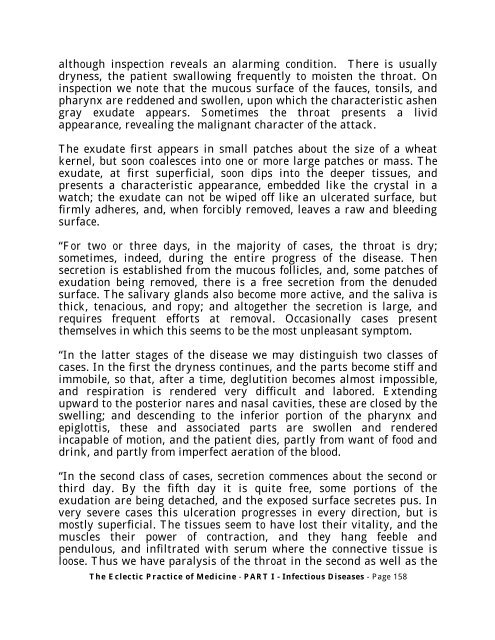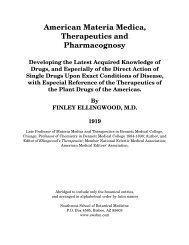SCARLET FEVER. Synonyms.—Scarlatina; Scarlet Rash. Definition ...
SCARLET FEVER. Synonyms.—Scarlatina; Scarlet Rash. Definition ...
SCARLET FEVER. Synonyms.—Scarlatina; Scarlet Rash. Definition ...
You also want an ePaper? Increase the reach of your titles
YUMPU automatically turns print PDFs into web optimized ePapers that Google loves.
although inspection reveals an alarming condition. There is usually<br />
dryness, the patient swallowing frequently to moisten the throat. On<br />
inspection we note that the mucous surface of the fauces, tonsils, and<br />
pharynx are reddened and swollen, upon which the characteristic ashen<br />
gray exudate appears. Sometimes the throat presents a livid<br />
appearance, revealing the malignant character of the attack.<br />
The exudate first appears in small patches about the size of a wheat<br />
kernel, but soon coalesces into one or more large patches or mass. The<br />
exudate, at first superficial, soon dips into the deeper tissues, and<br />
presents a characteristic appearance, embedded like the crystal in a<br />
watch; the exudate can not be wiped off like an ulcerated surface, but<br />
firmly adheres, and, when forcibly removed, leaves a raw and bleeding<br />
surface.<br />
“For two or three days, in the majority of cases, the throat is dry;<br />
sometimes, indeed, during the entire progress of the disease. Then<br />
secretion is established from the mucous follicles, and, some patches of<br />
exudation being removed, there is a free secretion from the denuded<br />
surface. The salivary glands also become more active, and the saliva is<br />
thick, tenacious, and ropy; and altogether the secretion is large, and<br />
requires frequent efforts at removal. Occasionally cases present<br />
themselves in which this seems to be the most unpleasant symptom.<br />
“In the latter stages of the disease we may distinguish two classes of<br />
cases. In the first the dryness continues, and the parts become stiff and<br />
immobile, so that, after a time, deglutition becomes almost impossible,<br />
and respiration is rendered very difficult and labored. Extending<br />
upward to the posterior nares and nasal cavities, these are closed by the<br />
swelling; and descending to the inferior portion of the pharynx and<br />
epiglottis, these and associated parts are swollen and rendered<br />
incapable of motion, and the patient dies, partly from want of food and<br />
drink, and partly from imperfect aeration of the blood.<br />
“In the second class of cases, secretion commences about the second or<br />
third day. By the fifth day it is quite free, some portions of the<br />
exudation are being detached, and the exposed surface secretes pus. In<br />
very severe cases this ulceration progresses in every direction, but is<br />
mostly superficial. The tissues seem to have lost their vitality, and the<br />
muscles their power of contraction, and they hang feeble and<br />
pendulous, and infiltrated with serum where the connective tissue is<br />
loose. Thus we have paralysis of the throat in the second as well as the<br />
The Eclectic Practice of Medicine - PART I - Infectious Diseases - Page 158

















